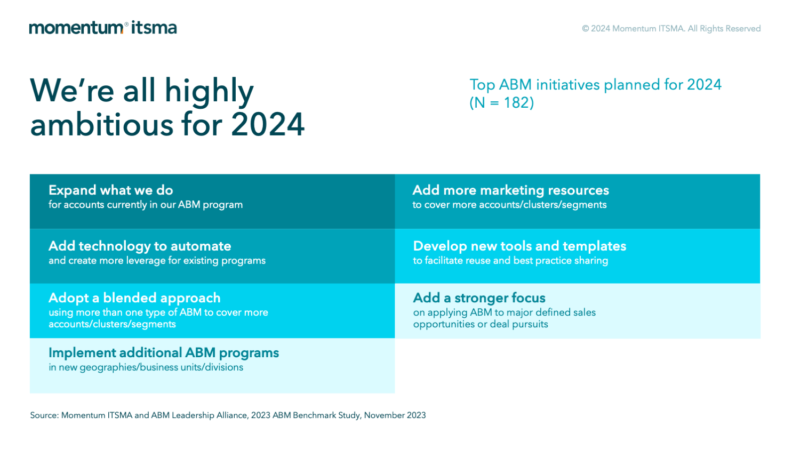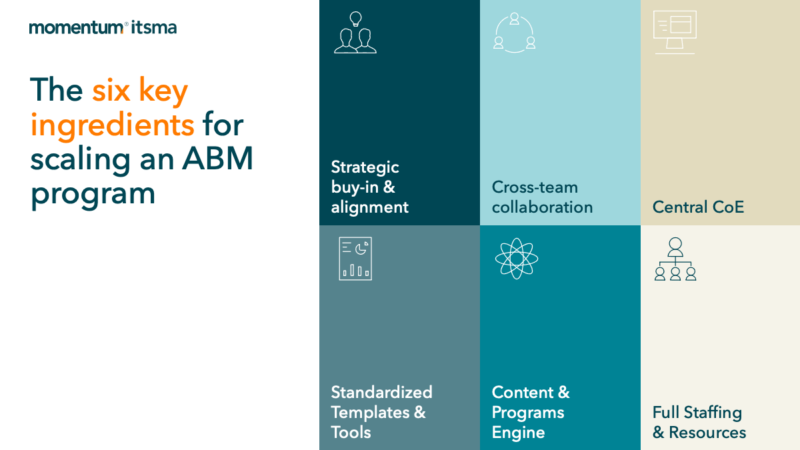ABM program leaders discuss scaling their ABM programs: Some of the highlights will surprise you
The topic of ABM program scaling continues to be front and center for ABM Leaders in 2024.
The top seven initiatives planned by ABMers this year (see below from the Momentum ITSMA 2023 Global ABM Benchmarking Report) all involve ways to expand what organizations do with their ABM accounts and ways to scale those activities to more accounts. But the challenges ABM leaders face scaling their programs are often company-specific ones. These challenges can cripple a program and test the acumen and resourcefulness of the most seasoned ABM program leaders.
This reality became clear during my recent sit down with half a dozen, global ABM program leaders. We dug into topic with the Global ABM Program Leaders Council during our quarterly roundtable. Let’s break it all down.

First, let’s tackle common approaches to scaling ABM programs. Leveraging technology, templates, and pre-existing assets are high on the list. Many Council members rely on highly specialized external agencies or internal, “special ops” marketing teams to develop and execute campaigns. One participant cited relying on agency partners to license and provide tech-as-a-service “outputs” to help overcome the barrier of getting new technologies onboarded.
Another strategy to scale was simply reducing ABM activities for some accounts. Creating a central ABM CoE, scored high in effectiveness for scaling. Tactical actions like moving from a 1:1 focus to a 1:few approach or loading more accounts onto existing ABM-ers’ remit was mentioned as a strategy that looked good on the white board, but was adopted rarely. A maverick in the group shared that their organization increased the number of accounts that their one:few ABM-ers handle and also lowered the number of accounts the one:one ABM-ers handle. Next, they lowered activities for the one:few accounts and expanded the activities for the one:one accounts. Through this “trial by fire” approach, they are achieving the rebalancing that ABM program scaling requires.
Transitioning accounts through ABM approaches
Council members also shared their experience on transitioning some of their one:one programs into one:few, cluster-based ABM. Recommendations include starting with one or two lead accounts in one industry. Use those accounts as a model to build out a cluster-based approach. Evaluate, learn and then execute for 10 to 20 similar accounts. Accounts should have high potential for growth and highly collaborative account teams, which will work with cross-functional teams to achieve results.
Another Council member shared that they completely reset their one:one accounts. They are laser-focused on the accounts on which their ABM team can add value. They are also building the next tier. By analyzing and attending to some one:few clusters, they can start to build awareness and relevance; positioning these accounts for more digital engagement and over time, identifying new one:one candidates for their existing one:one program.
As a part of our roundtable discussion, we took several polls and hashed out many approaches and strategies. The average number of ‘scaling approaches’ pursued equalled 3.5, highlighting the fact that picking the right approach, or combination of approaches, does not involve trying to do everything and depends on what makes the most sense for your company and situation.
When it comes to effectiveness, the top five approaches included leveraging templates and assets; leveraging technology; relying more on agencies and highly skilled, specialized internal groups; adding more skilled ABM-ers and achieving buy-in for more marketers to cover ABM accounts. Those ABM program leaders who create an ABM Center of Excellence had an advantage across the board, with respect to leveraging and executing effective strategies to engage in ABM at scale.
Stubborn obstacles to scaling ABM
As for scaling challenges, among Council members, two of the top four have to do with talent. Whether it is getting approval to hire more ABM-ers or to allocate funds to upskill and develop existing ABM-ers, building effective teams is tough. A few Council members said finding qualified ABM-ers was their biggest scaling challenge. One member shared that finding field marketers who can handle the distinct demands of strategic, one:one ABM is extremely difficult. Field marketers, who are a fit for campaign-centric ABM, like one:few or one:many, are more available.
One member of the Council overcomes resource restraints by relying on their organization’s executive engagement team to handle ongoing relationship building activities, and another team to handle ongoing reputation-building activities. This cross-functional approach allows their ABM account leads to focus more time on generating new growth opportunities and expanding their accounts.
Aligning ABM strategies for success
The final two challenges to scaling ABM relate to acquiring buy-in and funding for more effective ABM technologies.
At Momentum, we have an assessment tool that evaluates the Six Dimensions of ABM Scaling Success (see below). This assessment allows participants to measure how far along their organizations are in optimizing key dimensions to effective ABM scaling. Strategic buy-in and alignment, and standardized templates and tools, are the two dimensions most widely achieved by participants of the assessment. More participants feel they are further behind on establishing/optimizing a centralized ABM Center of Excellence than the other areas, with optimizing their content/program engines and ABM staffing and resourcing close behind.

Scaling an ABM program requires all the dimensions above but strategic alignment around client growth, with leadership buy-in and support, is the most important to optimizing the impact of an effectively scaled ABM program.
Companies who are focused on client growth, among their most important accounts, provide a North Star to help drive and support the development of the other five dimensions of ABM scaling success. Without that focus, ABM programs and practitioners will have a long road, pitted with additional challenges to scaling and achieving success.
If you are committed to sharpening your client focus and determined to drive market-beating growth, let us know. We have data-led strategies and proven experience to help you get where you want to go. See more details at Build Account-Based Strategy - Momentum ITSMA or contact me at dave.munn@momentumitsma.com. Also contact me if you are a Global, Regional, Divisional or CoE ABM Program Leader and are interested in being part of our Global ABM Program Leaders Council series of roundtables.
More in
-
The great B2B marketing reset: Why your team’s skills will define your success and growth trajectory
We read about it and we hear it all the time in our conversations with our clients: B2B marketing is under pressure like never before.
-
How future-ready B2B marketing teams win: Insights from the front lines of enablement
As an L&D Director working with top global B2B marketing teams, Jo Connolly reveals why enablement is the new growth engine – and how you can close the skills gap. Discover key findings and join our webinars for actionable strategies.
-
KPMG: The blueprint for high-touch, high-impact ABM
In this episode of the Account-Based Marketing podcast, Heather Adkins shares the art and science of scaling ABM through sector-driven teams, AI-powered agents, and a relentless client focus.